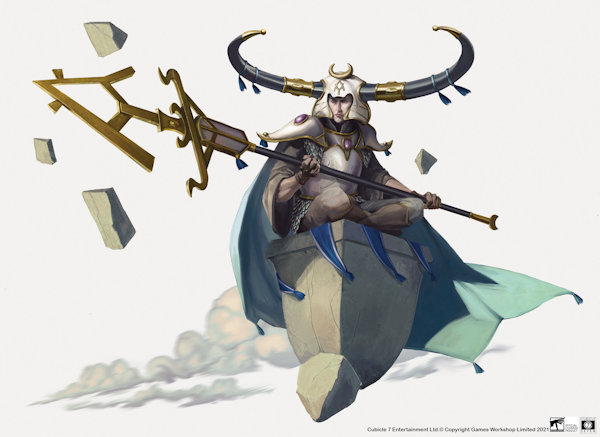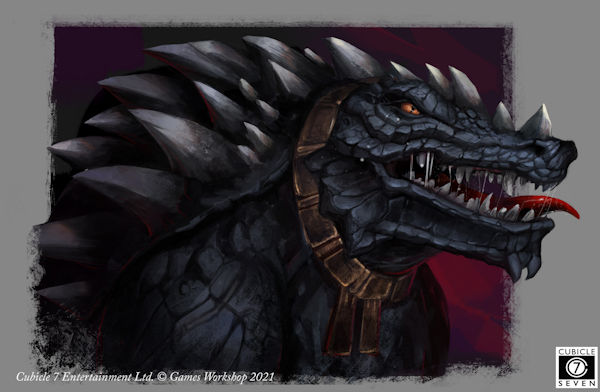A pair of roleplaying game (RPG) supplements this time, filling in some of the character options that didn’t fit into the Soulbound core book. (You’ll find these reviews a lot more comprehensible if you read my review of the Soulbound core book first.)
Champions of Order expands on playing characters from the Grand Alliance of Order, adding background/culture abilities, a new faction (the Lumineth Ream-lords), ten new Archetypes, more than a hundred new Talents, as well as new Miracles for the Gods of Order, new spells, and a bunch of new Endeavours to carry out during down time.
Stars and Scales provides options for including the Seraphon in your games, as allies, temporary party-members, and quest-givers. The Seraphon lizardmen are devoted to the fight against Chaos but are not and have never been a part of the Grand Alliance of Order.
Soulbound: Champions of Order
Introduction and Initial Thoughts
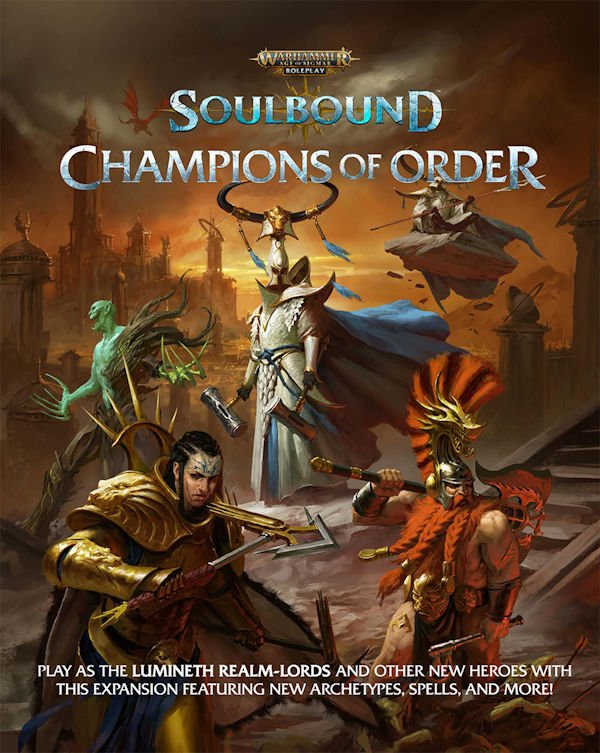 Cubicle 7’s characteristic excellent layout continues in this book. Explanations are given of the book and its contents at the start, with further breakdowns and explanations at the beginning of each chapter, making the book easy to follow and to use.
Cubicle 7’s characteristic excellent layout continues in this book. Explanations are given of the book and its contents at the start, with further breakdowns and explanations at the beginning of each chapter, making the book easy to follow and to use.
A key difference to character creation brought in by this book is the addition of sub-faction bonuses. Every player character gets a special Talent or other bonus that reflects the sub-faction of their overall culture they come from. This includes cities of Sigmar or the Idoneth Deepkin, Khainite temples, Sylvaneth glades and so on. These bonuses are an addition to the starting XP or ability options in the base game, making characters built using this book a little bit more powerful than those built using only the core book. It’s also a great way to add nuance to your characters and get some roleplaying ideas.
Background
This chapter expands on the lore of the Ritual of Binding. Each major god of the original Alliance of Order contributed to the original ritual, including Gorkamorka and Nagash. The book offers the option to have gods other than Sigmar perform a Soulbinding, with serious consequences upon those bound. This also leaves the door open for the gods of Death and Destruction to create their own bindings in future. (And, as I write this, Champions of Death just came out and has been added to my review queue, though it’ll probably be there for a while.)
We also get some ideas on creating your binding’s initial purpose, the effects it had on your character, and long and short-term goals. D6 tables are provided for those who like an element of chance in their character creation.
It’s all helpful enough, for those players or groups who, like myself, are less familiar with the Mortal Realms, or feel the need for a creativity boost. The faction specific goals were particularly interesting, as they added some extra context to the motivations of these groups. Some fun motivations include: destroying a Skaven war machine or rescuing a lost soul from the Realm of Death.
Archetypes
Of the ten new Archetypes, four are Lumineth Realm-lords.
The Lumineth culture is introduced here. The spiritual successors to the High Elves of Warhammer Fantasy, they hail from the Light Realm of Hysh and are proud, technologically advanced and emotionally detached.
During the Age of Myth, the Lumineth achieved unprecedented heights of technology, science, architecture and wisdom. Immortal mages competed to build the tallest and most beautiful towers to demonstrate their superior intellect and power.
As the authors state, “One day their growing egos and festering jealousies erupted in a cataclysmic civil war called the Spirefall, which saw continents crumble and reality itself shatter. The Lumineth faced extinction, and only by bonding with Hysh’s elemental spirits did they find the harmony necessary to save the land they had once sought to ascend beyond.”
This self-inflicted near destruction has given the surviving Lumineth a certain level of humility and introspection, to temper their natural arrogance. They still see the other mortal races as children to be guided and educated, however.
There’s no quick elevator pitch for the Lumineth. Unlike the Kharadron—sky dwarves with steam-powered jetpack balloons, or the Kurnothi—giant treemen, or the Daughters of Khaine—bikini-clad murder-cultists, or the Idoneth—soul-eating deep-sea elves who ride marine monsters that swim through a ghost sea. (Okay, not every faction has a short elevator pitch.)
Yet there’s some interesting detail to this proud people. They bind themselves to elemental spirits of the land, particularly mountain spirits. They use a mineral called aetherstone to drain away their emotions, leaving a Vulcan-like calm. Their Light Magic based science is far beyond even the steampunk technology of the Kharadron, in certain ways.
Lumineth warriors (Vanari) are clearly modelled on Ancient Greek hoplites, with high-crested helms, shields and long spears. This is Age of Sigmar, of course, so their spearheads are white-hot with Light Magic.
Contrasting with the cultural touchstones of their military, the philosophy Lumineth society was rebuilt on (after Spirefall) is one of duality and balance, broadly inspired by some of the trappings of Chinese philosophy—yin and yang, meditation, mandalas, geomantic forces. (It’s mainly Taoist as far as a I can tell, but I don’t know enough about Age of Sigmar or Taoism to conclude whether the resemblance is deeper than a few surface concepts, or whether this is a respectful borrowing from real world beliefs.)
The dualistic Lumineth philosophy is particularly inspired by the twin gods of the elves—Tyrian and Teclis.
“The left-hand ‘Tyrionic’ side represents Hysh’s blinding border, which appears as the sun to all other Realms, and also symbolises decisiveness and inspiration. The right-hand ‘Teclian’ side represents the true moon Celennar, as well as introspection and refinement. Most Lumineth choose one side or another to follow, though some, like the loreseekers, embody both.”
The Lumineth live in eight cities, of which four are described in this book. Standouts include:
- The scientists of Iliatha have discovered the art of cloning. (You don’t get more than one per person though.) Heroes from this city can have their clone twin take over for them if they die.
- Zaitreci Lumineth are intensely curious about other forms of magic and can learn styles normally unavailable to them, such as the magic of The Deeps.
Lumineth Archetypes
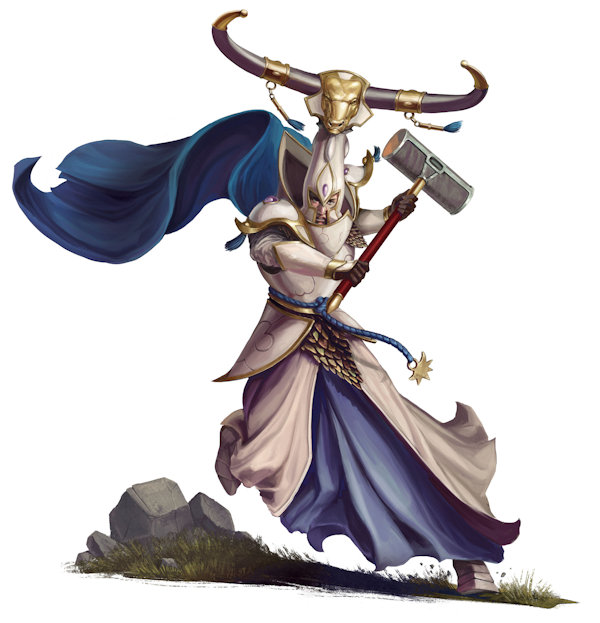 Alarith Stoneguards are mystical mountain warriors who wield great hammers. They’re an odd bunch—part of their training involves being buried alive. Stoneguards are so devoted to their realm that the risk of having their soul shattered and absorbed by the land upon death is actually a plus for them.
Alarith Stoneguards are mystical mountain warriors who wield great hammers. They’re an odd bunch—part of their training involves being buried alive. Stoneguards are so devoted to their realm that the risk of having their soul shattered and absorbed by the land upon death is actually a plus for them.
Their unique Talent, the Mountain Stance, makes them better at knocking people over, impossible to knock down themselves, and capable of shoving other characters out of their Zone. It’s a very tactical ability which requires either a clever player or a thoughtful GM to get much use out of.
Stoneguards have tall, curved helmets topped with a metal bull’s head, complete with implausibly large horns. If this wasn’t Age of Sigmar, I’d say they were unusually flamboyant and over the top.
Alarith Stonemages wield the magic of the High Peaks.
The book notes elves had to scale the Chaos-scarred mountains and die in droves to earn the mountains’ forgiveness for the events of Spirefall. But at last, they succeeded and now Stonemages can serve as diplomats to other geomantic spirits of the Realms. Which offers some interesting roleplaying opportunities.
Stonemages have helmets with very large horns as well, though they’re not as tall as the Stoneguards’ helmets. Fitting through doors must still be a problem though.
Scinari Cathallars are Light mages who use aetherquartz to gather and safely dispose of the negative emotions their allies suffer.
They get a very cinematic description:
“Trained Cathallars are so attuned to the rising fumes of pure, psychic distress that they can manipulate them with a breath. Thus do the Lumineth’s enemies see a veiled figure striding toward them, the soil cracking and the grass withering beneath the Aelf ‘s feet, before dark smoke washes over them and sends them into twitching paroxysms of grief, guilt, and despair.”
The in-game power this translates into seems a bit specific and damaging, the character takes a Wound in return for bonuses based on the current level of Doom. This might be more impressive in play.
Vanari Warriors are the aforementioned sun hoplites.
“Gleaming like the sun, you fight beside your allies with manoeuvres as deadly as they are beautiful.”
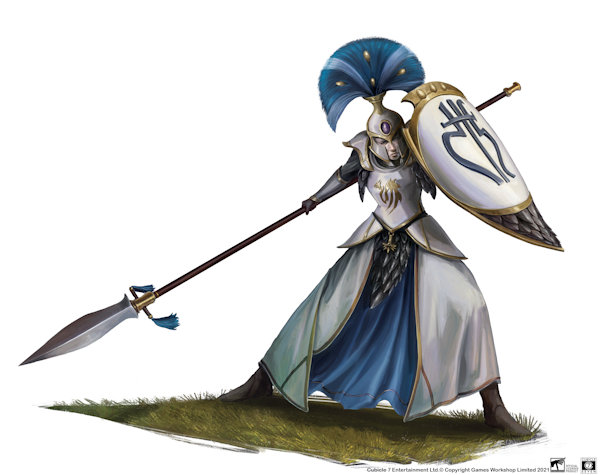 Vanari can be archers, spearmen or cavalry. Their unique Talent lets them team up with an ally in close range to get a bonus to combat, which is both thematic and effective.
Vanari can be archers, spearmen or cavalry. Their unique Talent lets them team up with an ally in close range to get a bonus to combat, which is both thematic and effective.
The rest of the chapter consists of backgrounds and Archetypes for the existing factions of Order. In many ways, this is the meat of the book, providing more details on the different places your heroes could hail from or adventure through and deepening the reader’s understanding of the setting considerably. It was here, three books in, where I finally felt I was getting a handle on the Idoneth Deepkin and their relationship to Sigmar’s Alliance of Order.
The Cities of the Free Peoples offer no new Archetypes, but some fascinating places to explore. With a note that many diverse cultures are thrust together in these cities, and conflict is common. I’m going to go into more detail on this section because it really showcases the range of weird and wonderful locations which Soulbound can offer.
Brightspear stands proudly upon the Disintegrating Shore, menaced not just by the ocean but also by the ever-shifting horror of the Chaos God Tzeentch’s realm. Its people are born survivors.
Hammerhal Aqsha was built upon the skill of its seven military guilds, while the citizens of Hammerhal Ghyra have less martial skill but manage to thrive through a sheer stubborn refusal to falter or die.
Greywater Fastness’s artillerists unleashed so much destruction on the surrounding woodlands to repel an attack by Beastmen that the city now stands in a blasted wasteland. The local Sylvaneth hate this city and would love to see its gun-toting citizens brought down.
Excelsis, was ruthlessly conquered by a brutal host of Stormcast Eternals and built around a fragment of the original Warhammer World. This city exports shards of magic fortune-telling stone.
Lethis, is my favourite of them all. I really want to play a game there!
“With its towering gothic spires casting their shadows across the inky black water of an unfathomably deep lake, Lethis is a foreboding sight even for the realm of Shyish.”
This city’s name references the River Lethe, said to be one of the four rivers of the Underworld in Greek Mythology. Its people worship a lost god of death and enchant their weapons with talismans of feather and bone to make them proof against undead and demons.
Misthavn, wandering fleet city of the Realm of Shadow. Its denizens always have another identity to assume when things go south.
Settler’s Gain, the quintessential Lumineth city. A gleaming metropolis of towering spires and solar-powered automatons. Those who live here practice the art of Xintilogica, which appears to be a fantastical version of Feng Shui and grants bonuses to Mind or Soul rolls.
Vindicarum, built into the inner slops of a quicksilver volcano. Its people are excellent at sniffing out Chaos, due to many attempts at infiltration by the ruinous powers, and subsequent, insanely bloody, purges by the Stormhost who rule this city.
Next, we have different temples of the Daughters of Khaine.
All Daughters of Khaine want to stab people to death. Different temples practice, different styles of stabbing, or focus on slightly different aspects of that murder-cultist life.
There are the fanatical warriors of Hagg Nar. The blood-drenched, ritualistic executioners of Draichi Ganeth. Who literally get a bonus to Defence after messily killing a foe. The Crimson Cult, the violentest of the violent, who have no interest in honour, mercy or artistry, and think even having temples is needless distraction from the business of killing. And the seemingly more pleasant Khailebron blade-dancer assassins.
 The new Khainite Archetype is the Khainite Shadowstalker: a blank-masked assassin, magically bound to Ulgu, the Realm of Shadow, and cut off from the rest of their society.
The new Khainite Archetype is the Khainite Shadowstalker: a blank-masked assassin, magically bound to Ulgu, the Realm of Shadow, and cut off from the rest of their society.
Fyreslayer lodges are next.
“Each lodge has developed both a unique style of ornamentation to their loincloths and girdles.”
(Tells you all you need to know really.)
This section expands a bit on the Fyreslayers, noting that rebuilding their shattered warrior god, Grimnir, is their primary concern. All else, including the cause of Order and loyalty to their allies, is secondary.
Interesting lodges include:
- Lofnir: These dwarves venerate Vulcatrix, mother of salamanders. They are zealous, soot-stained, and fire-resistant.
- Tangrim: A young, idealistic lodge, they have allied themselves with the Stormcast and sworn never to serve Chaos. (Which tells us most Fyreslayers aren’t so choosy.)
- Caengan: Assassins and covert warriors who dwell in Ulgu. They are legendary for their punishment of oath-breakers, having destroyed an entire kingdom for failing to pay them.
- Baeldrag: Dedicated hunters of Skaven.
 Grimwrath Berzerker, the new Fyreslayer Archetype, is really just a Fyreslayer plus. They’re so stuffed full of magical Ur-runes, it’s a wonder they haven’t exploded.
Grimwrath Berzerker, the new Fyreslayer Archetype, is really just a Fyreslayer plus. They’re so stuffed full of magical Ur-runes, it’s a wonder they haven’t exploded.
The Idoneth Deepkin section provides a good insight into their politics and why some of their enclaves might be working with Sigmar.
- Ionrach: Claiming to be the first Idoneth enclave, they have far reaching influence and are more willing than most enclaves to work with other cultures. More Soulbound come from their ranks than any other Idoneth group.
- Dhom-Hain: By contrast, are a savage, isolationist enclave.
- Mor’phann: Horrible people, but very cool.
“They descend through ethersea mists on pale tentacled beasts and camouflaged Ghost Fangmora, alternating between wailing battle cries and silence, as their eyes roll back in their skulls. Mortal wounds barely slow the Mor’phann, as no enclave’s Soulrenders are more adept at siphoning souls from fallen enemies to empower their allies.”
“You are a terrifying vision of death: pale-skinned with glowing white eyes, circled by freezing ethersea mists that chill the hearts of your enemies.”
Despite their horrific appearance, this Enclave has recognised the danger posed to all the Realms by Nagash’s faction of Death, and so are willing to ally with Sigmar.
- Nautilar: Built on the shell of a Giant Scaphodon (your guess is as good as mine). They work with Sigmar because a joint force of Ionrach warriors and Stormcast Eternals saved them from a Skaven invasion.
The Isharran Soulrender Archetype is so important to understanding and playing the Idoneth, I’m surprised it didn’t make it into the core book.
When the Deepkin raid the dwellings of land-dwellers to harvest their souls, these are the elves who have the thankless task of actually gathering those souls with their sorcerous lurelights. Even other Deepkin find the Soulrenders distasteful. Bindings are likely to be uncomfortable with this morbid harvest, even as they reap the benefit in healing and Soulfire.
With Kharadron Overlords we have some fresh insights as well.
“Many outsiders mischaracterise Kharadron society as covetous and corrupt, stealing from honest Sigmarites and cheating their way out of business arrangements. Whilst the Kharadron are skilled in exploiting contractual loopholes, they honour the letter of agreements as diligently as any Duardin. It is not greed that compels the Kharadron to stockpile aether-gold, but necessity.”
The different Kharadron subcultures include bold explorers, militaristic champion-hunters, and sharp dealers who earn the reputation for extortion, which is somewhat unfairly applied to their kin (and might now seek to redeem themselves in their allies’ eyes by contributing to Soul Bindings).
Most exciting was Barak-Mhornar. The people of this city are privateers, ambushers and thieves. They have collectively committed so many crimes that the whole city has now been transported out of its home in the Realm of Metal and gone on the run. Another place I’d love to visit!
The Aetheric Navigator is a more tactical (less shooty) Kharadron Archetype. They can control winds, see magic and unbind enemy spells. An interesting addition.
A grim introduction to Stormcast Eternals explains how even the souls of the Stormcast can be destroyed, damned or lost, giving the lie to their title of Eternals.
This section adds a bit of variety to the Stormhosts. I particularly enjoyed the description of the Celestial Vindicators as teal-armoured avenging angels who worship the amalgamated spirit of the twelve Runefangs. (If you know, you know.)
Other little twists on the Stormcast formula are:
- Anvils of the Heldenhammer: heroes from ancient times, resurrected after countless ages. Despite their glorious pasts, they all fear Nagash, god of Death, because they know what he can do to them.
- Celestial Warbringers: gifted seers who can foresee their own death and work to avoid it.
- Astral Templars: raised from the souls of ‘barbaric’ peoples, they excel at hunting.
The Stormcast Archetype is the Knight Zephyros. These warriors are raised from the souls of assassins and king-slayers who hunted the champions of Chaos even after their own civilisations were destroyed. They are feral warriors attuned to the wind; they strike like lightning.
- The Sylvaneth glades are differentiated by outlook, abilities and elemental properties.
- The Gnarlroot are isolationists who hoard occult secrets, making them excellent opponents for ruthless or desperate bindings in need of curious forgotten lore.
- The Ironbark are literally able to absorb liquid metal from Chamon (the Realm of Metal) to strengthen their bodies.
- The “rime-frosted” Winterleaf are merciless and cold; they attack with the ferocity of despair.
- The Dreadwood are malicious, murderous, vicious, cruel. Which makes them the ideal glade for the new Archetype—the Spite-Revenant.
- Spite Revenants are part tree, part ghost, all monster. They are the vengeance and hatred of their goddess, given mortal shape.
“They move with reckless speed and the jerky unsteadiness of marionettes, and cast flickering twilights that exaggerate their gnashing teeth and rending talons.”
The Revenants are so eerie in their movements, so vicious in their attacks, that any enemy they wound in melee risks succumbing to unnatural terror. Order may be the good guys, if only in comparison to the other Grand Alliances, but they’re definitely not nice.
Overall, I most appreciated the insight this chapter gave me into the different factions of Order, and their internal and external politics. Some beautiful writing as well. Some of the Archetypes on offer felt like they had quite a narrow focus, and I can see why they didn’t all make it into the core book.
Talents and Miracles
New character types and backgrounds are fun, but this section is perhaps the most useful part of the book, massively expanding the range of options available to characters, and filling in some gaps I hadn’t even noticed were there.
You can overcharge your aethermatic explosives, at the risk of having them explode whenever you get hit in combat.
Or have such a burning faith in Sigmar that your blood cleanses tainted lands and burns Daemons like acid. (Sort of a reverse xenomorph.)
Or adorn yourself with trophies taken from slain foes, giving yourself extra Mettle in combat.
Dwarves can tap into their ancestral grudges against certain groups or individuals. Sylvaneth can grow bark talons. Idoneth can resist pain by recalling the unimaginable suffering their soul once endured in the belly of the Chaos god Slaanesh.
There are lots of less flashy, but very useful abilities too. Counterattacks, a bonus to called shots and another for duelling, dirty fighting tricks, a very anime-style ability to wield massive weapons in one hand, skill with poisons, lip reading, a Talent that lets you carry yourself with such confidence that others have a hard time disbelieving or refusing you, and one that lets you inspire your allies by rushing into the forefront of battle.
Mages haven’t been neglected either. They can meditate to increase their power, at the cost of being less aware of their surroundings, or use the pain of their wounds to fuel their magic. (Supremely skilled warriors can learn to attack spells with their weapons, unbinding them with sheer finesse and/or brute force.)
The Miracles section is pretty fun. Each god gets five new Miracles, and there are five new Universal Miracles as well.
All Devoted can now learn to exorcise daemons or bless or curse those around them. Again, very useful additions that seem obvious in hindsight.
More specifically:
- Devoted of Alarielle can summon carnivorous plants, creating the possibility of staging a live version of Little Shop of Horrors. They can also rip a creature’s heart out and turn it into a seed; if planted this seed will regrow into that creature. (No doubt some player will find a use for that.)
- Devoted of the ethersea can smother with silence or unleash dark alien tentacles of fear!
- Devoted of Grimnir can encourage their enemies to move faster by lighting them on fire.
- Dwarven forge god Grungni didn’t have any Miracles in the core book. So, he gets a double helping here. His priests can animate objects, resist fire, weaponize the ringing of the forge, enchant weapons, or magically bind an opponent with a simulacrum of the black chain which Grungni used to “seal the Gate of Deepest Night”. (I don’t know what that is, but it sounds very metal.)
- Khaine’s Devoted can give themselves and their allies combat bonuses by whispering murderously to themselves. They can also track heartbeats.
- Sigmar, the man himself, lets his worshippers stave of death or summon their own personal hurricane to stand in.
Teclis also gets ten Miracles, due to not appearing in the first book. His brother Tyrian still doesn’t get a look in. Teclis is focused on magic and many of his Miracles interact with it e.g., reducing the difficulty of casting, or causing enemy mages to suffer harm when they try to draw magic. He also likes wisdom and learning and has Miracles that bolster these or turn them to new purposes. Then there’s the Miracle I have renamed Magic Laser Eyes, because that’s what it does.
Spells
Each form of magic gets another five spells. Magic of the High Peaks debuts with fifteen spells, to keep up with the others.
I’ll just pick out a few spells from some of the lores.
Necromancers can now sing a dirge which weakens enemies by reminding them of death. Or create a spectral hourglass that drains the lifeforce of an enemy with every grain of sand that falls. (Surely both are contenders for the coveted title of ‘Most Goth Spell Ever’.)
 Bright mages can, counterintuitively, create darkness with a cloud of ash. They also have a spell that can either work as a torch, or a remote-controlled bomb. (Don’t get those two mixed up.)
Bright mages can, counterintuitively, create darkness with a cloud of ash. They also have a spell that can either work as a torch, or a remote-controlled bomb. (Don’t get those two mixed up.)
Celestial mages get some immensely powerful storm spells. Thunderstrike, in particular, is so complex and difficult that a Stormcast Lord Arcanum spending both their points of Mettle in the same Turn would still fail to cast it most of the time. I guess this must be an end game ability.
Gold mages get an orbiting razor sphere, which is nice.
Grey mages can infiltrate a target’s dreams or trick reality into forgetting an opponent’s armour exists. They can also make an enemy’s shadow corporeal and force it to wrestle them, which is an oddly hilarious image.
Deep Mages can briefly shapeshift into a wave.
Mages of the High Peaks can encase a foe in rock, open fissures in the ground, summon predatory bird spirits, shape rock as though it were clay, exude supernatural calm, inflict vertigo, or cause gravity to press down painfully hard on an enemy and release its grip on the caster allowing them to fly for the duration of the spell.
Overall, this section really showcased the ingenuity of the writers—their ability to find new and interesting ways to turn the themes of the different magical lores into gameable powers.
Equipment
This chapter offers a few fun toys, and a couple of potential quests to gather them.
Don a diving suit and plumb the depths in search of Black Pearls (they grant a bonus to Defence, so it’ll be worth your while, as long as you don’t get eaten by a sea monster).
Pluck an Etherflower, it’ll let you pass through vegetation as though it wasn’t there.
Fire armour-destroying rune bullets or wield venom so potent, it causes the victim to explode into a red mist.
There are some magical drugs as well. One lets you fly until, unexpectedly, you can’t anymore. One lets you walk through walls. Another makes you fight better. Side effects include a craving for raw meat, vivid nightmares or falling out of the sky.
Kharadron dwarves in particular get to light a target up with green smoke, summon aetheric winds or create the perfect shooting conditions.
Between Adventures
This chapter presents thirty-eight new Endeavours (actions you can take during down time). There are some enjoyably weird and fantastical options in this list, as well as some very practical ones. Grow poisonous mushrooms, establish a new trade route, fortify an area, open a bookshop, sow terror amongst your enemies, perform a blood ritual, seek the wisdom of your mountain spirit, steal souls, or skin a Skaven Grey Seer and fashion his verminous hide into a cloak.
You can also throw a feast so awesome, it reduces the amount of Doom (a measure of general despair and the power of evil in the local area).
We also get a list of Contacts—powerful individuals who can provide a wide range of services. Assassins, engineers, mages, mercenary leaders, priests, ship captains, and so on. Useful enough.
Conclusion
I was drawn to this book by the chance to learn about the Lumineth, and the offer of new Archetypes. And those are quite fun. But if you’re deciding whether to get this book, I would say it’s real selling points are:
- The list of backgrounds, which are invaluable for players looking to create unique characters but also extremely handy for GMs who have never played the Age of Sigmar wargame or read the books and want more context for the politics of the Realms.
- And the new Talents, Miracles and Spells. These hugely expand the options for character creation and round out the game very well.
The new Endeavours are a nice addition too, helping to bind the player characters into the setting and emphasise its high fantasy weirdness.
If you want more context for Soulbound’s setting, or if you want a much bigger range of options for building your own characters, if you can’t get enough of the Realms, this is the book for you. It’s well written, well laid out and useful.
Soulbound: Stars and Scales
“They come from the stars—reptilian warriors trailing comet tails of light and burning atmosphere, wielding golden artefacts that crackle with celestial energies.”
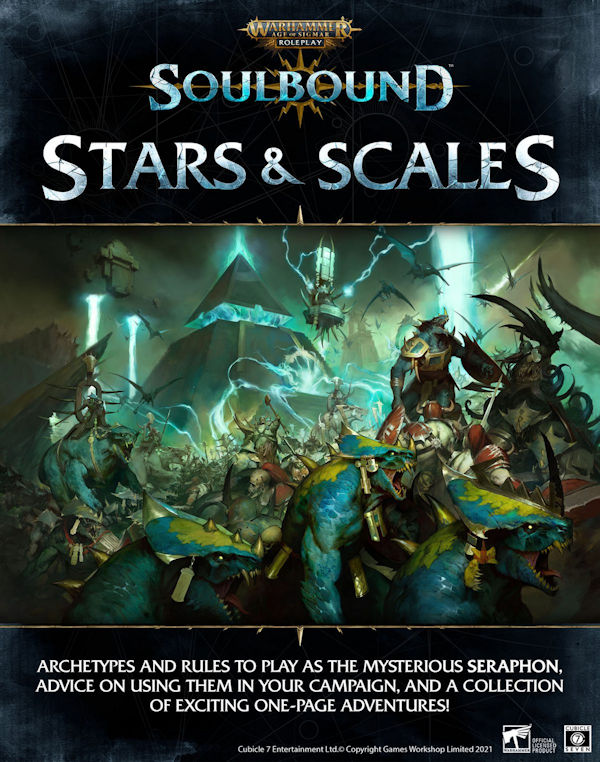 This short supplement offers advice on incorporating Seraphon into your game, some Archetype, Talent, Background and Spell options for Seraphon player characters, several short adventures and some Seraphon-focused Endeavours.
This short supplement offers advice on incorporating Seraphon into your game, some Archetype, Talent, Background and Spell options for Seraphon player characters, several short adventures and some Seraphon-focused Endeavours.
Seraphon
The Lizardmen army from the old Warhammer World have been transformed into the Seraphon. These beings live in huge ships that float high in the skies of the Mortal Realms (or possibly orbit them, astronomy is a difficult concept in this setting). The ships form Constellations of glowing lights in the sky, each one representing a different group of Seraphon.
The Seraphon, led by the ancient, toad-like, Slann, seek to fulfil the Great Plan of the Old Ones. Those god-like beings were the first to oppose Chaos and have left age-spanning instructions on how to destroy it for good. Alas, even the Seraphon don’t agree on precisely how this plan should be implemented. Nonetheless, they send armies and individuals down to the Realms to interfere in the course of history so the Plan might come about. Though, technically, benevolent they are always playing the long game and don’t care about collateral damage, honour or anything else that might bother ordinary mortals. This makes them chancy allies at best.
There are four kinds of Seraphon.
- Slann are all ridiculously powerful, ancient wizards with an incredible mastery of divination. No new Slann have been made since before the Mortal Realms existed, so their time is literally running out.
- Saurus are hardy, taciturn lizardmen built only for war. They have horned heads and tough scales.
- Skinks are clever, agile and quite chatty by Seraphon standards. They do most of the work in Seraphon society and can even take over responsibilities the Slann are no longer able to complete. They dress in flashy jewellery and feathers and have bright crests on their heads.
- Kroxigor are giant crocodile-men. They aren’t particularly intelligent but, unlike most Seraphon, they are capable of affection, which they lavish on their Skink handlers.
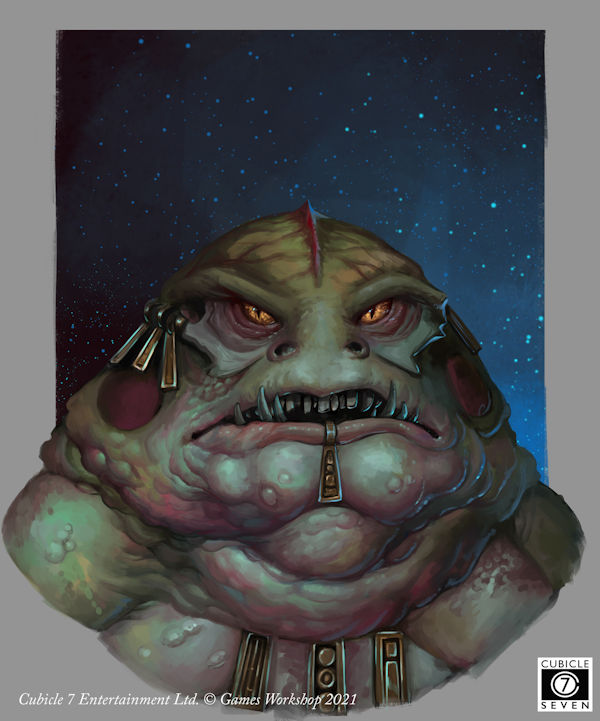 Some Seraphon are no longer able to become starlight and return to their ships or choose to stay in the Realms. These Seraphon build great temple cities and use Realmshaper engines to turn the local area into the primeval jungles they and their beasts prefer.
Some Seraphon are no longer able to become starlight and return to their ships or choose to stay in the Realms. These Seraphon build great temple cities and use Realmshaper engines to turn the local area into the primeval jungles they and their beasts prefer.
This chapter emphasises just how alien Seraphon are. They have comparatively little sense of individuality. They rarely show ambition. They don’t care about treasure unless it can be used to further the Great Plan. Luxury, envy, love, compassion, all are irrelevant to the Seraphon.
This chapter also offers some advice on portraying the enigmatic Seraphon, including some ideas for physical mannerisms.
“Their difficulty communicating and their inability to compromise make them frustrating allies, but they are certainly dedicated ones. If they believe the party has a role to play in the Great Plan, they shall go to any lengths to protect them.”
The chapter finishes with a helpful breakdown of the adventures on offer and how they can be used.
The Starherd’s Path
This Constellation is, by default, the one encountered in the adventures listed in this book. They are a small Constellation with a focus on defence. Their Slann wishes to end all wars that aren’t dedicated to destroying Chaos and will dispatch Seraphon to shore up the defences of any other faction that is under attack. The Starherd’s Path will even switch sides in a conflict if their current allies go on the offensive. I appreciate this characterisation; it makes perfect sense to the Seraphon, but it looks treacherous and random to their erstwhile allies.
In the distant past, the Starherd’s Path built many cities, fortifications and artefacts for mortal societies to use in their rise to civilisation. This leaves the door open for all sorts of tomb raiding and treasure hunting adventures.
Chotec’s Feather
This ferocious Constellation believes the conquest of the Sigmarite city of Anvilguard by the newly ascended dark elven god Morathi is a vital part of the Great Plan. Thus, they conspired to prevent the rest of Sigmar’s forces finding out about it until too late. Another interesting demonstration of how the Seraphon’s long game approach can push them into conflict with more short-sighted factions.
Threats
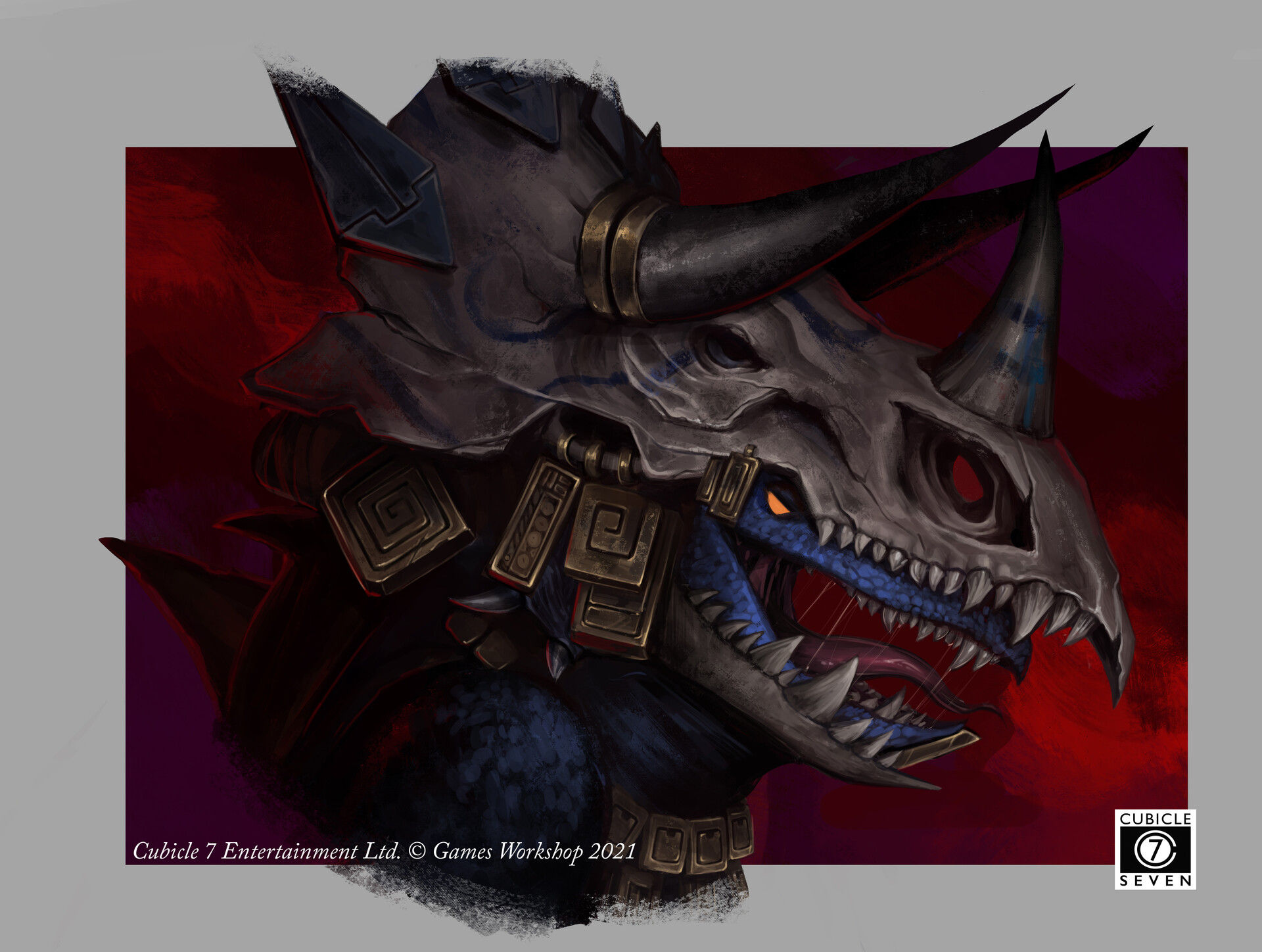 This is the adventure section. The first six adventures are a page long each and can form a connected campaign. The last adventure is described in a bit more detail and can serve as an epilogue to the campaign or a standalone adventure; it offers the chance to gain Seraphon contacts.
This is the adventure section. The first six adventures are a page long each and can form a connected campaign. The last adventure is described in a bit more detail and can serve as an epilogue to the campaign or a standalone adventure; it offers the chance to gain Seraphon contacts.
Each of the first six adventures is described as a Rumour, then Fear, and finally a Threat. I found this demonstration of the progression from Rumour to Threat very useful.
There are some fun ideas here. An archaeological dig unearths a dinosaur skeleton, which is soon claimed by the Ossiarch Bonereapers. The binding must escape a vast, trap-filled temple while avoiding its huge, unkillable guardian. The party rides Terradons in order to battle Daemons in the sky. There is the chance for negotiation with different factions, as well as pure combat. The final adventure offers a suitably satisfying conclusion that draws together the disparate elements of the previous adventures.
The adventures themselves contain no maps, though stats for characters are provided in the appendix, where they don’t appear in the core book. It would take some work from a GM to fill in the specifics of the adventures and run them properly.
I did like the note at the start of this section that explains how this campaign leans into the weird ufology angle of the Seraphon and their artefacts, after all, they are ancient alien space dinosaurs! This demonstrates the joy the authors take in engaging with the rich and wacky lore of the Mortal Realms and encourages the reader to do the same.
Playing Seraphon
 This chapter begins by declaring every time anyone has tried to bind the soul of a Seraphon to another creature everyone involved has exploded. Seraphon cannot join bindings. The authors advise against trying to play Seraphon in longer campaigns at all. This is an unusual approach, effectively discouraging the reader from using this book for what may be the most common sort of roleplaying—a campaign.
This chapter begins by declaring every time anyone has tried to bind the soul of a Seraphon to another creature everyone involved has exploded. Seraphon cannot join bindings. The authors advise against trying to play Seraphon in longer campaigns at all. This is an unusual approach, effectively discouraging the reader from using this book for what may be the most common sort of roleplaying—a campaign.
Next, we get details of the species bonuses for Skinks or Saurus and for spaceship dwelling Starborne Seraphon (they bleed starlight), or the earth bound Coalesced.
We get another four Constellations and their background bonuses. For example, the insidious Fangs of Sotek intend to create a new Grand Alliance of Order, under their control. They are excellent at infiltrating mortal society and react faster in the first round of combat. Meanwhile, the Seraphon of Dracothion’s Tail can teleport by turning into starlight.
There are just two new Archetypes on offer.
The Saurus Oldbloods are ancient, immensely strong warriors with an unmatched experience of tactics. Rules wise, they’re mainly straight-up fighters, with an incredibly high starting Body and the ability to spend their Mettle more efficiently in combat. The only thing that represents the Oldblood’s tactical acumen is an optional Talent called Wrath of the Seraphon, which grants bonuses to an ally’s combat skills if the Saurus spends an Action exhorting them.
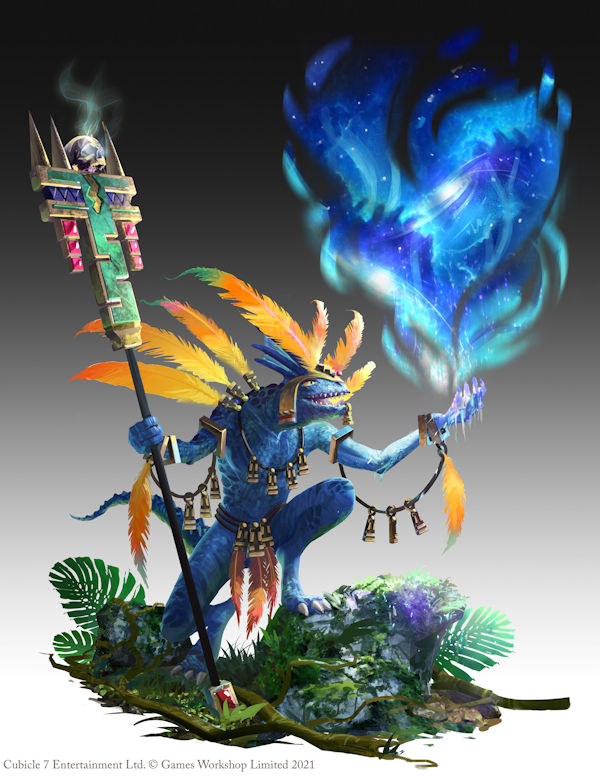 The Skink Starpriests are spawned specifically to be Celestial mages and star-readers. They can also serve as ambassadors, advisers or assassins. Starpriests have an optional Talent that lets them read the future and, in game terms, store up Successes to use later, like a Slann. They do have a good reason to assist a binding—it’s an excuse to study the group and divine their likely impact on the tides of fate.
The Skink Starpriests are spawned specifically to be Celestial mages and star-readers. They can also serve as ambassadors, advisers or assassins. Starpriests have an optional Talent that lets them read the future and, in game terms, store up Successes to use later, like a Slann. They do have a good reason to assist a binding—it’s an excuse to study the group and divine their likely impact on the tides of fate.
There are seven new Talents. Aside from those mentioned previously, the standouts are a bite attack Talent for Saurus and a chameleon skin ability for Skinks.
And four new Spells. Though, technically, Celestial Spells, these feel mostly like spells that just fit the themes of the Seraphon. Celestial Harmony boosts Defence for allies in a Zone, another spell blinds enemies with starlight and the last one straight up summons a tide of serpents. (Which, admittedly, is very cool and a perfect response to any player characters who disturb an ancient jungle temple.)
Between Adventures
This is a list of seven new Endeavours exclusively for Seraphon. Spawn a baby dinosaur, Consult the Great Plan, transform the local area into something more hospitable for your primeval people, or use your foresight to remove a potential problem before it happens.
Appendices
These list the different characters and monsters that feature in this book’s adventures. More interestingly we also get stats and descriptions for some Seraphon artefacts—Realmshaper engines, poison staves, Daemon-banishing gauntlets that fire bolts of weaponised sunlight, and magic fossils!
Conclusion and Fan Theories
It’s hard for me to judge Stars and Scales without harping on what it isn’t.
Allow me to indulge myself a little.
There is, in theory, enough material in the Seraphon background from the Age of Sigmar wargame to provide a small but beautiful spin-off game from Soulbound, complete with a faction that could support campaign play as easily as any of the core cultures.
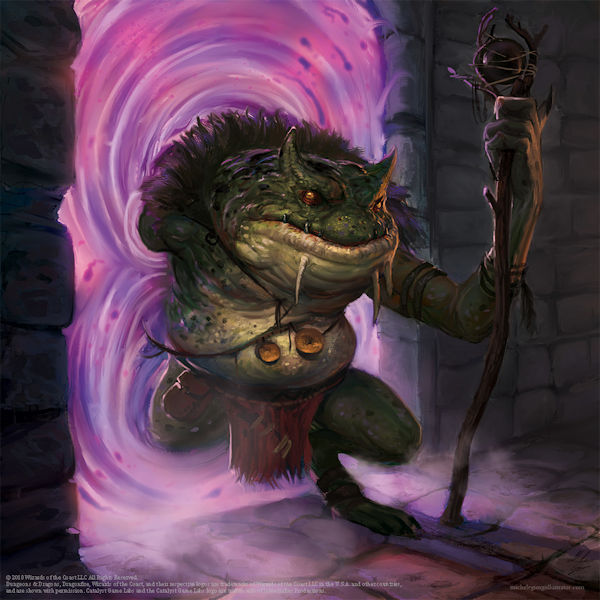 Sure, Seraphon might not become Soulbound. They have no relationship with any of the gods involved in the creation of that lore. But they’re arcane beings woven from starlight and led by some of the most ancient and powerful mages in the setting. They could find a substitute. E.g., a Slann develops a method for binding the fates and essences of a group of Seraphon together—now they’re Starbound and they share a mystical resource called Starfire (no relation to the DC character). Replace one of the abilities of Soulfire with a group teleport ability to represent the Starbound deploying as bolts of light, and you’re good to go.
Sure, Seraphon might not become Soulbound. They have no relationship with any of the gods involved in the creation of that lore. But they’re arcane beings woven from starlight and led by some of the most ancient and powerful mages in the setting. They could find a substitute. E.g., a Slann develops a method for binding the fates and essences of a group of Seraphon together—now they’re Starbound and they share a mystical resource called Starfire (no relation to the DC character). Replace one of the abilities of Soulfire with a group teleport ability to represent the Starbound deploying as bolts of light, and you’re good to go.
A little sidebar could explain the “everyone explodes when you Soulbind Seraphon” thing. Then detail a few quick notes about how you could work around that in your game if you wanted to. (Note that Champions of Death allows for the possibility of vampires, wights, ghosts and ghouls joining Order Soul Bindings.)
These Star Bindings could be deployed as part of the Great Plan, intervening all over the Realms to tip pivotal events in the right direction. Or they could be left in one place to fight Chaos however they see fit—their ability to exercise free will is somehow integral to the Great Plan. And why limit ourselves to Skinks and Saurus? Kroxigor as written might not be bright enough to make player characters, but a rare new breed of more intelligent Kroxigor could be unveiled for this supplement. One Slann could have attempted to clone himself, creating much weaker, playable versions of Slann, the process could have killed that Slann and been banned by the other Starmasters, but the surviving clones could have been put to work. (We know from Champions of Order that cloning is possible in this setting.)
There are certainly more Archetypes you could throw in on top of that. A beast tamer/rider with a unique Talent taht helps get the most out of the prehistoric beasts so iconic to the Seraphon faction. A Skink infiltrator/assassin who specialises in stealth and poison. A Saurus Eternity Warden who excels at protection and defence. A horribly deformed Slann clone with eerie powers.
That’s just something I threw together, Games Workshop and Cubicle 7 could, I’m sure, come up with something much better.
Why didn’t they?
I can only guess. However, in my experience, Cubicle 7 make great books, so I have no doubt they would have expanded on this fun and characterful faction if they could have. My guess is, they were working within a very limited brief from Games Workshop. The trouble with licenced products is—the licence holder’s wishes override whatever the publisher wants to do.
Age of Sigmar is a sprawling intellectual property that spans RPGs, wargames, board games, novels, and video games. Fan investment in the metaplot of that property is a key selling point of Games Workshop’s products, so the metaplot needs to be respected. You don’t want to mess up a faction’s unique schtick too much. For the Seraphon that’s their alien nature, the unbreachable distance between them and the other factions of Order.
I reached out to a friend who is a fan of the wargame and its associated novels. He thought the very idea of Seraphon as player characters was weird, because Seraphon are just the manifested memories of the Slann. Which suggests Games Workshop were right to avoid rocking the boat too much by allowing a longer Seraphon supplement to exist.
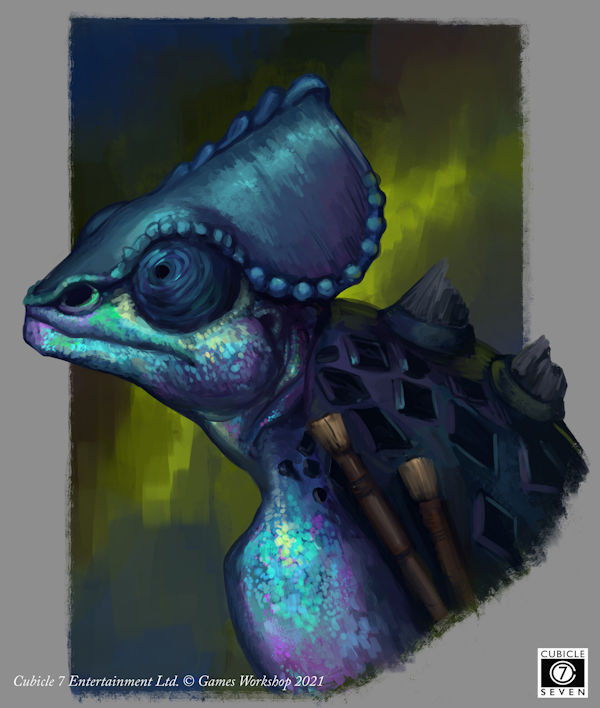 It’s also possible that Games Workshop has specific plans for the Seraphon and their ongoing role in the saga of the Mortal Realms. (I don’t what those plans, if any, could be. I’m hoping for a triumphant and catastrophic return of a bunch of godlike Old Ones who turn out to be far less benevolent than the Seraphon would have you believe, but I seriously doubt it’s in the cards.) A more extensive Soulbound expansion on the Seraphon could have gotten in the way of those plans, whatever they are.
It’s also possible that Games Workshop has specific plans for the Seraphon and their ongoing role in the saga of the Mortal Realms. (I don’t what those plans, if any, could be. I’m hoping for a triumphant and catastrophic return of a bunch of godlike Old Ones who turn out to be far less benevolent than the Seraphon would have you believe, but I seriously doubt it’s in the cards.) A more extensive Soulbound expansion on the Seraphon could have gotten in the way of those plans, whatever they are.
I don’t blame Games Workshop for looking after their core fans. But it does leave this supplement feeling like an exciting flirtation that fizzles out into a taunting failure to commit. Character creation rules that don’t create a full faction, the bones of a campaign without enough meat on it. I think I’d have preferred a book of the same length that only focused on character creation or a full campaign book without any new player character options.
There’s nothing wrong with the content we do get. It’s well written and characterful. If you’re a fan of the setting and you want to include Seraphon in your campaign or one-shots as allies, antagonists, or both, this book has got you covered.
If you were hoping to run a campaign with Seraphon as the main characters, this book is a solid starting point, but you’ll need to do some more work yourself.

